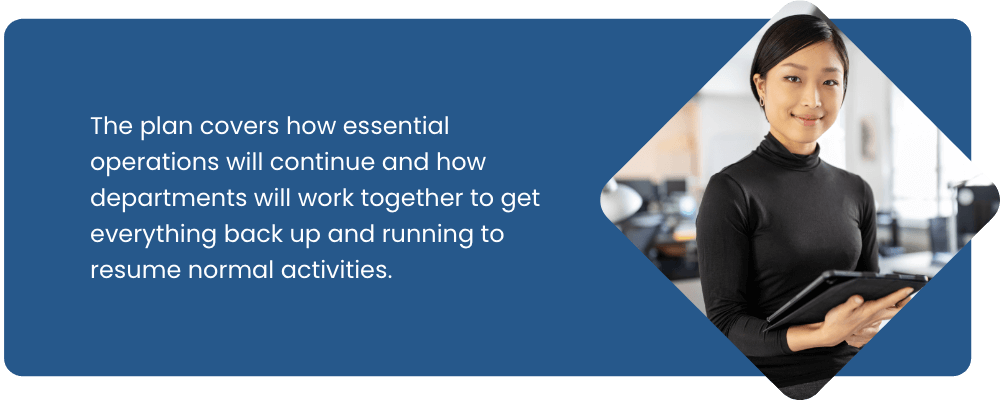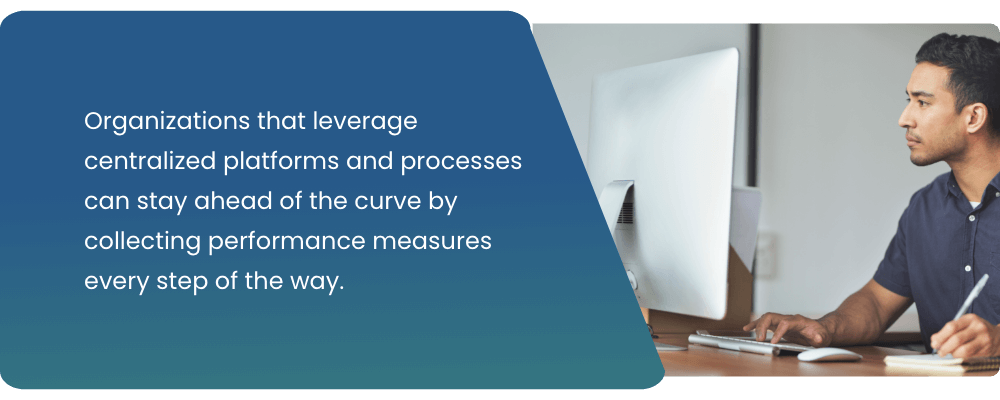Virtually every government agency or municipality has a COOP. For many, it’s something that is hidden away in a back office with the hope that it never needs activation. While primarily leveraged in government organizations, a COOP can be impactful in any type of organization.
In dire times, it can the single most important plan ever created for your organization. Understanding what a Continuity of Operations Plan (COOP) is and how to ensure a successful launch can make a world of difference in a time of crisis.
What is a COOP?
A COOP, or Continuity of Operations Plan, is a document that is created to identify how a government agency or business will handle an emergency or hazard. The plan covers how essential operations will continue and how departments will work together to get everything back up and running to resume normal activities.
A COOP will include tasks that need to be performed and who will be responsible for completing each task. Further, it identifies the resources needed to keep essential operations running during any kind of disruption or emergency, including such things as food and shelter, payroll, communication, security, and more.
FEMA, the very organization designed to deal with emergencies on a federal level, has established a continuity plan template that local and state governments can follow. It incorporates a number of components into the plan including:
- A list of essential functions
- Support functions
- Expected costs
- Responsible personnel
- A “GO” kit to include an order of succession and a communications systems table
- Establishment of alternate locations
- A training, testing, and exercise (TT&E) program

The Benefits of a COOP
There are countless benefits of having a COOP, which is why FEMA and many other government entities provide a detailed explanation of how to create one.
The Ohio Emergency Management Agency identifies the benefits of a COOP as being able to meet the expectations that citizens have of the government to ensure that services are provided regardless of the situation. Further, a continuity of operations plan ensures that citizens and government leaders understand the importance of changing the way the government operates to keep everything running as smoothly as possible given the specific emergency.
Some of the top benefits include:
- Reduce loss of life
- Minimize damage
- Protect essential assets
- Maintain a succession of leadership
- Reducing the disruption of key operations
- Achieve a timely recovery
While establishing COOPs can be drastic in some situations, they are critical to maintain or restore order. With everyone aware of the benefits of having a COOP and putting it into motion, it’s easier to get everyone’s participation and understanding during the emergency.
While non-government organizations have different concerns and responsibilities as states, counties, and cities, the importance of creating and maintaining a COOP plan persists.
Ways to Be Successful with Your COOPs
It’s one thing to have a COOP plan, but proper execution is the true value of an organization’s COOP and supporting processes. Execution is where many governments fail, leading to chaos in at least one area. There are many ways to be more successful with a COOP, and much of that involves having the right toolkits in place. Here are a few ways we’ve seen organizations succeed with COOPs, or similar plans:

1. Focus on the Big Picture
One of the most important ways to be successful when you put a COOP into motion is to ensure you remember the big picture, the entire organization. It is easy to get distracted by one program or department. Additionally, each program or department may be using different methods for tracking progress and communication, making it difficult to organize a uniform response.
If you are unable to get a big picture overview, it can make it difficult to know how you’re doing overall. When you’re able to get everything into view, you can answer key questions on your own without having the POC from every department report into you, taking time away from all that they’re doing.
2. Keep Everyone Engaged
Everyone needs to be engaged when an emergency strikes. Within your COOP, it may only be outlined to include what the POC for each department needs to be doing. But, each and every employee within your government agency is affected – and they need to be contributing to the continuity plan in their own unique way.
Identify how each department and each employee can do their part. Empower each department leader to cascade the COOP plan to their teams. Display and communicate initiatives and major metrics to show progress, accomplishments, and work required before normal operations can resume.
3. Provide Training
Employees aren’t going to know how to put a COOP into motion unless you provide training and expectations. Although you hope never to have an emergency that requires a continuity plan, it’s best to be prepared for the worst.
The type of training is going to vary based on the level of each employee. Within each department, identify a Point of Contact (POC) and provide them with a higher level of training geared at the responsibilities that come with the role. The training should be cascaded down throughout the organization accordingly.
Additionally, as FEMA recommends, there should be various tests conducted. This involves a mock emergency to see how everyone has responded to the training. This allows a quick understanding of how quickly everyone acts and focuses on their areas of responsibility. After a test is conducted, it can highlight areas where additional training is needed.
When circumstances are past the point to provide training, leverage constant feedback to help teams learn
4. Establish Checklists
No matter how much training you provide, checklists ensure that everyone is doing what they need, when they need to do it. Whether the checklists are on pieces of paper or maintained digitally is up to you. However, it makes it easier to track progress when everyone is ticking boxes as things are done.
Checklists should be prepared for every stage of your COOP. This ensures that you not only have the organizational leadership in place but also the resources and training required to execute the plan.
In many instances, you won’t be able to move from one stage to the next without completing a checklist. Having exit criteria will ensure no preceding steps are missed as you progress through your plan. Especially when an emergency lasts for weeks or months, the checklists allow you to stay focused.
While “checklists” can often sound elementary and simple, the form can change based on the complexity of the organization. Some may find it best to have simple to-dos. Others will have a series of projects, initiatives, and metrics guiding their response.
5. Ensure Communication is in Place
Communication is often the downfall when an emergency occurs. Depending on the type of emergency, especially a natural disaster, certain levels of communication may be down, too. As such, you need to be prepared to communicate with your team using any method necessary.
It’s best to have several forms of communication ready to go at a moment’s notice. It is also advantageous to maintain a list of contact information. Every department POC should have several ways to be contacted so that they can be tasked with executing their part of the COOP.
Further, you will want to maintain communication with your team to ensure that they are moving forward. If there are issues with any aspect of a task, you need to know about it to provide sufficient support. POCs should have access to progress reports to meet and adhere to deadlines.
And with communication interrupted, it’s often not as easy to “run down the hall” to collect an update. It’s vital to ensure a proper way of ensuring everyone understands the plan, progress towards the goal, and results.

6. Utilize Technology to Help with Tracking and Monitoring
The moment an emergency strikes, people begin to panic. Even government leaders will panic despite having their strategic plan of attack with a COOP. Choosing to use a centralized way to track and monitor the execution of the plan keeps everyone focused on what needs to be done. It also ensures that leaders have a full view of all that’s going on so that they know where to lend more support.
With a centralized view, needs and resources can be aligned more effectively to improve the execution of your COOP. Manual update collection can be automated, increasing time to focus on bigger issues. Additionally, you can hold POCs accountable with due dates while being able to see all that’s happening from a single dashboard.
Organizations that leverage centralized platforms and processes can stay ahead of the curve by collecting performance measures every step of the way.
Local government planning can be as comprehensive as you choose to make it. When you have a COOP in place, it allows you to respond more effectively to a disaster as opposed to waiting for FEMA or another federal entity to come in and take over. You have a responsibility to the community and with a continuity plan in place, you can slowly work to resume normalcy.
Having a COOP is important, but executing a plan properly is even more important, and that’s where we can help. At AchievieIt, we offer a comprehensive solution to support your local government’s plan. Contact us to schedule your free demo with us today.
About AchieveIt
AchieveIt is the platform that large organizations use to get their biggest, most important initiatives out of the boardroom and into reality. Too many great ideas never quite make it across the finish line, because there’s no real way to keep everyone on course and keep everything on track. What does it take to actually guide these initiatives all the way through to completion? You’ve got to:
- Get everything in view – so you can see what’s happening with every initiative, at every level, from the enterprise to the individual, in real time.
- Get everyone engaged – with an easy-to-use platform that connects your organization from the executive leadership to the project teams, keeping everyone accountable and on the same page.
- Get every possible advantage – not only because you have the premier platform in this space, but because you can draw on the experience and best practices of our execution experts.
That’s why everyone from global corporations, to regional healthcare systems, to federal agencies have turned to AchieveIt for their Integrated Plan Management. Let’s actually do this.



